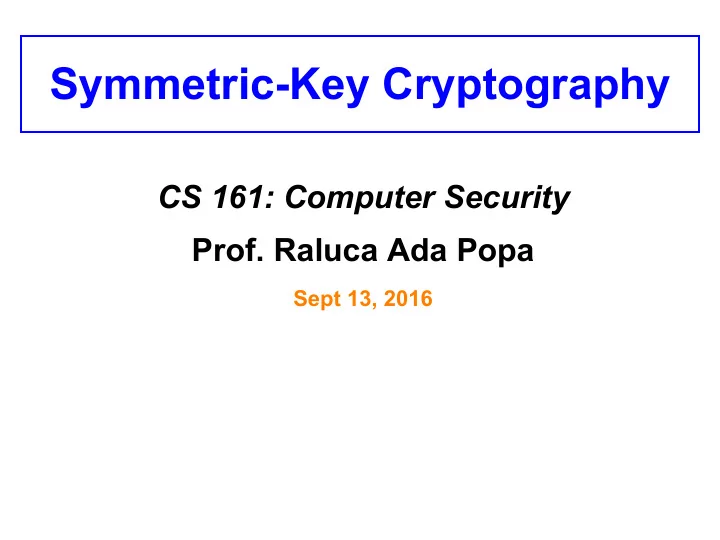

Symmetric-Key Cryptography CS 161: Computer Security Prof. Raluca Ada Popa Sept 13, 2016
Announcements • Project due Sept 20
Special guests • Alice • Bob • The attacker (Eve - “eavesdropper”, Malice) • Sometimes Chris too
Cryptography • Narrow definition: secure communication over insecure communication channels • Broad definition: a way to provide formal guarantees in the presence of an attacker
Three main goals • Confidentiality: preventing adversaries from reading our private data, • Integrity: preventing attackers from altering some data, • Authenticity: determining who created a given document
Modern Cryptography • Symmetric-key cryptography – The same secret key is used by both endpoints of a communication = • Public-key (asymmetric-key) cryptography – Sender and receiver use different keys =
Today: Symmetric-key Cryptography Whiteboard & notes: - Symmetric encryption definition - Security definition - One time pad (OTP) - Block cipher
Advanced Encryption Standard (AES) - Block cipher developed in 1998 by Joan Daemen and Vincent Rijmen - Recommended by US National Institute for Standard and Technology (NIST) - Block length n = 128, key length k = 256
AES ALGORITHM • 14 cycles of repetition for 256-bit keys. AES slides, credit Kevin Orr
Algorithm Steps - Sub bytes • each byte in the state matrix is replaced with a SubByte using an 8-bit substitution box • b ij = S(a ij )
Shift Rows • Cyclically shifts the bytes in each row by a certain offset • The number of places each byte is shifted differs for each row
Uses • Government Standard – AES is standardized as Federal Information Processing Standard 197 (FIPS 197) by NIST – To protect classified information • Industry – SSL / TLS – SSH – WinZip – BitLocker – Mozilla Thunderbird – Skype But used as part of symmetric-key encryption or other crypto tools
Symmetric-key encryption from block ciphers
Why block ciphers not enough for encryption by themselves? • Can only encrypt messages of a certain size • If message is encrypted twice, attacker knows it is the same message
Original image
Eack block encrypted with a block cipher
Later (identical) message again encrypted
Symmetric key encryption scheme • Can be reused (unlike OTP) • Builds on block ciphers: – Can be used to encrypt long messages – Wants to hide that same block is encrypted twice • Uses block ciphers in certain modes of operation
Electronic Code Book (ECB) • Split message M in blocks P 1 , P 2 , … • Each block is a value which is substituted, like a codebook • Each block is encoded independently of the other blocks 𝐷 𝑗 = 𝐹𝐿(𝑄𝑗)
Encryption P 1 P 2 P 3 C 1 C 2 C 3 KeyGen = key gen of block cipher Enc(K, P1|P2|P3) = (IV, C1, C2, C3) Dec(K, (IV,C1,C2,C3)) = (P1, P2, P3)
Decryption C 1 C 2 C 3 P 1 P 2 P 3 What is the problem with ECB?
Does this achieve IND-KPA? No, attacker can tell if P i =P j
Original image
Encrypted with ECB
Later (identical) message again encrypted with ECB
CBC: Encryption P 1 P 2 P 3 C 1 C 2 C 3 IV may not repeat for messages with same P 1, choose it at random
CBC: Decryption C 1 C 2 C 3 P 1 P 2 P 3
Original image
Encrypted with CBC
CBC Popular, still widely used Achieves IND-KPA, and more (IND-CPA) Caveat: sequential encryption, hard to parallelize CTR mode gaining popularity
CTR: Encryption Enc(K, P1|P2|P3) = (nonce, C1, C2, C3) P 1 P 2 P 3 C 1 C 2 C 3 Nonce is similar to IV for CBC, one should not use the same nonce for two messages; choose it at random
CTR: Decryption Dec(K, (nonce,C1,C2,C3)) = (P1, P2, P3) C 1 C 2 C 3 P 1 P 2 P 3 Note, CTR decryption uses block cipher’s encryption , not decryption
CBC vs CTR Security : Both IND-KPA, and even IND-CPA If you ever reuse the same nonce, CBC might leak some information about the initial plaintext blocks up to a first difference between two messages. CTR can leak information about various blocks in the message. Speed: Both modes require the same amount of computation, but CTR is parallelizable
Summary • Encryption protects confidentiality • IND-KPA is a security game expressing message indistinguishability • OTP is secure if used only once • Block ciphers help build symmetric-key encryption schemes with reusable sizes and arbitrary message lengths by chaining them in cipher modes
Recommend
More recommend